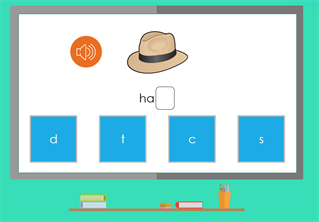
More help:
NWEA Support
Have an idea?
Share it!
Dyslexia Screener
The MAP Reading Fluency Dyslexia Screener is a test type that can identify when students' performance demonstrates possible risk factors for dyslexia or other reading difficulties. The screener collects data using Foundational Skills measures and a Rapid Automatized Naming (RAN) measure, then uses a predictive model to flag students.
Dyslexia Screener Basics
| Purpose | Screens for possible risk factors for dyslexia or other reading difficulties |
| Grade levels | K–3 |
| Test content | Foundational Skills and Rapid Automatized Naming (RAN); identifies students with possible risk factors for dyslexia or other reading difficulties |
| Administration types | Onsite and remote |
| Frequency | Up to three times per year |
| Test time | About 20 minutes to assess an entire class simultaneously |
| Accessibility | Audio instruction, color contrast adjustment, and magnification |
| Technology required | Devices and headsets for each student |
| Language | English only |
Continue reading or select a link to jump to a specific section about the Dyslexia Screener.
Dyslexia screener defined: What is a dyslexia screener vs. a diagnostic assessment?
A screener is generally defined as a brief universal assessment used to identify students who may need follow-up. A diagnostic, usually used for a subset of students, is a deeper-dive assessment or evaluation that is focused on why and how the student struggles.
The MAP Reading Fluency Dyslexia Screener is a screener only. It is not meant to diagnose dyslexia or other reading difficulties.
Comparison Between Screener and Diagnostic
| Screener | Diagnostic | |
|---|---|---|
| Description |
Brief measure that quickly identifies where students are in various academic areas Typically, universal in nature to identify students who may need additional follow-up |
Deeper-dive assessment or evaluation Used to understand why and how a student is struggling in a particular area or multiple areas |
| Example | MAP Reading Fluency Dyslexia Screener | In-depth analysis by an educator trained in dyslexia, like a school psychologist |
What is included in the Dyslexia Screener test type?
In the Dyslexia Screener, students will complete the Foundational Skills assessment and the Rapid Automatized Naming (RAN) measure. To compare the Dyslexia Screener to the other MAP Reading Fluency Test Types, refer to the table Test Segments and Skills Assessed in Each Test Type.
Foundational Skills
This section tests students on phonological awareness, phonics and word recognition, language comprehension, and sentence reading fluency.
Example of Foundational Skills measure:

Rapid Automatized Naming (RAN)
The Rapid Automatized Naming measure, or RAN, assesses a student’s naming speed, by timing them on retrieving and saying the name for a simple object shown on screen. For students who struggle with foundational reading skills, low naming speed may be an additional risk factor for difficulties in developing reading fluency.
Example of a screen from the RAN measure:

Assigning the Dyslexia Screener
You may choose to assign the Dyslexia Screener as one of the test types in the Assignments tab.
Dyslexia Screener results
Dyslexia Screener outcomes are available in the Screener Outcomes report. Depending on what type of data you’d like to review, this Dyslexia Reports by Level of Data table can help you to choose which report to consult. For teachers, we recommend starting with the class-level Screener Outcomes Report and using that as a jumping-off point to access student-level data. To learn more about Dyslexia Screener results refer to Results from the Dyslexia Screener.
Dyslexia Reports by Level of Data
| Level of Data | Recommended Report |
|---|---|
| District | Term Summary Report—for administrators only |
| Class | Screener Outcomes Report—recommended starting point for teachers |
| Individual student | Individual Student Report |
Learn more about dyslexia
Check out the dyslexia series on the NWEA blog—Teach. Learn. Grow.—to learn more about dyslexia, screening, and intervention.
-
5 things to know about the new MAP Reading Fluency Dyslexia Screener
-
Best practices in reading instruction for students with dyslexia